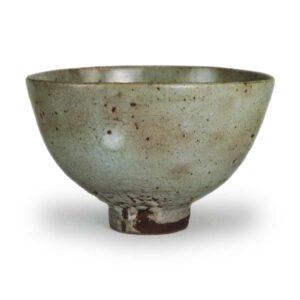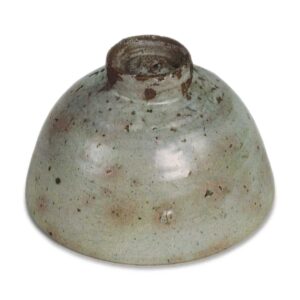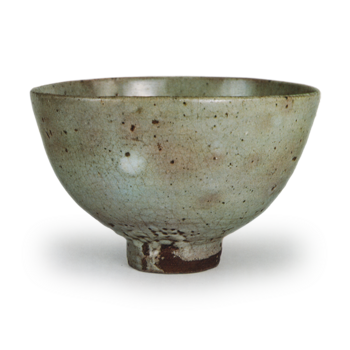

Height: 9.4-9.5cm
Diameter: 14.6-15.0
Outer diameter of foot: 4.8cm
Height: 1.5cm
Many of the hard-walled tea bowls, whether they are called “Nagasaki” or “Shinonome”, have a rough and rugged feel. However, this tea bowl is bulky and large, but it has a gentle and relaxed feel to it. The clay is slightly iron-rich and rough, and it contains small iron particles, which are commonly called sesame, and there are large and small blackened grains on the inside and outside. It is covered in a thick layer of transparent glaze, and the thick glaze pool has become cloudy and translucent after firing. The foot ring and the tatami mat are not covered in glaze and are stained a dark brown, but the underside of the base is covered in a thin layer of glaze. The foot ring is thickly glazed, and the clay has been scraped away, so there are uneven patches of kaeragi (a type of crackleware). Normally, kawara-te is free of cracks, but this tea bowl has rough cracks all over, giving it a soft feel. This is probably why some people call this tea bowl “kawara-te with a soft hand”.
The shape is relaxed and spacious, and the foot is tall and narrow, which is unusual for kawara-te. There are several fine finger marks on the body, but they are not as thick and strong as a well. The inside is deep, and the inside of the bowl is dimpled in a spiral pattern, with five eyes around it. There are also fine iron grains scattered all over the inside, but the large iron grains near the rim are blackened, and the slightly larger grains of feldspar have melted and shine white, adding to the scenery. The foot ring is a typical bamboo-joint foot ring, and it is tightly drawn together to give it a solid feel. The bottom of the inside is whorled after being scraped, and it is clear that it was scraped with a left-handed six-sided tool. The center of the bottom stands up like a helmet, and there are five marks on the tatami mat, but they are dirty with tea stains and it is not clear.
The firing was slightly reductive, and the overall color is a somber blue-gray, but there are pink flecks (called “hon”) all over the inside and outside of the bowl, in a pattern resembling a deer’s spots. The flecks appear when the firing is not quite done, and are caused by a slightly oxidizing reductive atmosphere called “neutral flame”. The reason this bowl has a soft feel to it is probably because the firing was not done at a very high temperature. There are many things to see, such as the rich shape, the high foot ring that is well-defined, the kaaragi (a type of patterning), the taste of the foot ring where the glaze does not cover the whole surface, the large white glaze pool on the body, and the white grains of melted stone on the opposite side white grains of melted stone, etc., but the most striking feature of this tea bowl is the pink speckles on the inside and outside, and the name “Kasumi” (haze) was probably given to this bowl because of this feature.
This tea bowl was originally owned by Kamio Bizen no Kami, a pupil of Kobori Enshu, and tea masters revere the tea bowls owned by Kamio Bizen no Kami as the “Kamio Kura-cho” (Kamio’s storehouse). It is also illustrated in the “Kamo-kou Ocha-ki Hikae” (a record of tea utensils owned by the Kamo family), and is a rare example of a tea bowl with a tight-fitting lid. The subsequent history of the bowl is unclear, but it was owned by Prince Katsunosuke Inoue in the Taisho era.
The inner box is made of paulownia wood with gold powder lettering, and the word “Kasumi” (haze) is written in the upper right corner, with the words “Katte-chawan” (tight-fitting tea bowl) below. The author is unclear.



